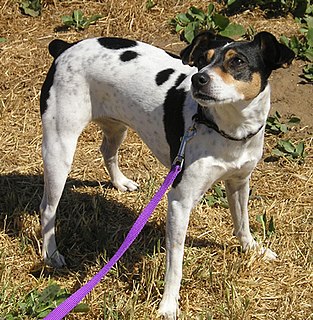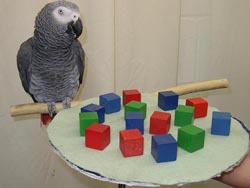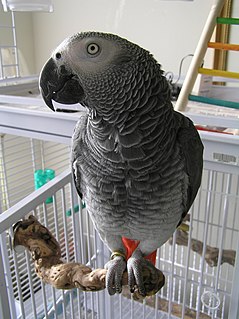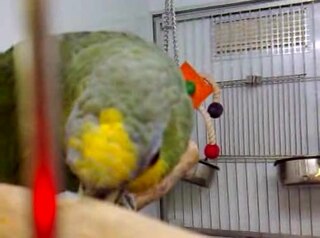Purpose and use
A parrot harness may enable a companion parrot to be taken outdoors while restraining it and preventing it from flying away. Some parrots may dislike wearing a harness and bite at it, but parrots that are harness-trained from a very young age may accept them willingly; more often, though, parrots must be very carefully and gradually accustomed and trained to wear a harness. Care must be taken that the parrot does not feel threatened. Properly trained parrots often appear to enjoy wearing their harnesses if they associate them with going outdoors.
If the harness is attached to a long leash, the parrot can be given some limited flight outside. However, this can be potentially dangerous for the parrot, which may be initially frightened by unfamiliar events, noises, and objects. It is usually best to first take the parrot out in a cage or carrier to let it become accustomed to being outdoors. Parrot harnesses are available commercially in a range of brands and sizes, fitting small birds such as budgerigars and cockatiels, all the way up to the largest macaws and cockatoos. Some parrot owners may choose to make their own harnesses.
Heavy harnesses that require assembly with metal buckles and clips can be uncomfortable. They may be broken or unlatched by some larger birds with strong beaks. A leash should always be fastened securely to the person holding the leash (such as by an elastic band around the wrist) to avoid the possibility of dropping the leash, as a dropped leash may become entangled in a tree or other object if a parrot flies off. A harness should only be used when the parrot is supervised and should never be used to tether a parrot to a perch or other object.
Parrots can be trained to wear a harness using positive and negative reinforcement. Negative reinforcement is used to reward the parrot until it overcomes its fear of the harness. Food treats are used as positive reinforcement to reward the parrot for putting on the harness. A well trained parrot will put the harness on itself by slipping its head through the collar. [1]

The budgerigar is a long-tailed, seed-eating parrot usually nicknamed the budgie, or in American English, the parakeet. Budgies are the only species in the genus Melopsittacus. Naturally, the species is green and yellow with black, scalloped markings on the nape, back, and wings. Budgies are bred in captivity with colouring of blues, whites, yellows, greys, and even with small crests. Juveniles and chicks are monomorphic, while adults are told apart by their cere colouring, and their behaviour.

A cockatoo is any of the 21 parrot species belonging to the family Cacatuidae, the only family in the superfamily Cacatuoidea. Along with the Psittacoidea and the Strigopoidea, they make up the order Psittaciformes. The family has a mainly Australasian distribution, ranging from the Philippines and the eastern Indonesian islands of Wallacea to New Guinea, the Solomon Islands and Australia.

The Tanimbar corella also known as Goffin's cockatoo or the blushing cockatoo, is a species of cockatoo endemic to forests of Yamdena, Larat and Selaru, all islands in the Tanimbar Islands archipelago in Indonesia. It has been introduced to the Kai Islands, Indonesia, Puerto Rico and Singapore. This species was only formally described in 2004, after it was discovered that the previous formal descriptions pertained to individuals of a different cockatoo species, the Ducorps' or Solomons cockatoo. Tanimbar corellas are the smallest of the white cockatoos. It is classified as Near Threatened due to deforestation and bird trade. It breeds well in captivity and there is a large avicultural population.

The cockatiel, also known as weiro bird, or quarrion, is a small parrot that is a member of its own branch of the cockatoo family endemic to Australia. They are prized as household pets and companion parrots throughout the world and are relatively easy to breed. As a caged bird, cockatiels are second in popularity only to the budgerigar.

Wing clipping is the controversial process of trimming a bird's primary wing feathers or remiges so that it is not fully flight-capable, until it moults, sheds the cut feathers and grows new ones.

The yellow-tailed black cockatoo is a large cockatoo native to the south-east of Australia measuring 55–65 cm (22–26 in) in length. It has a short crest on the top of its head. Its plumage is mostly brownish black and it has prominent yellow cheek patches and a yellow tail band. The body feathers are edged with yellow giving a scalloped appearance. The adult male has a black beak and pinkish-red eye-rings, and the female has a bone-coloured beak and grey eye-rings. In flight, yellow-tailed black cockatoos flap deeply and slowly, with a peculiar heavy fluid motion. Their loud, wailing calls carry for long distances.

The white cockatoo, also known as the umbrella cockatoo, is a medium-sized all-white cockatoo endemic to tropical rainforest on islands of Indonesia. When surprised, it extends a large and striking head crest, which has a semicircular shape. The wings and tail have a pale yellow or lemon color which is exposed when they fly. It is similar to other species of white cockatoo such as yellow-crested cockatoo, sulphur-crested cockatoo, and salmon-crested cockatoo, all of which have yellow, orange or pink crest feathers instead of white.

A leash is a rope or similar material used to control an animal by attaching it to a collar, harness, or halter.

Alex was a grey parrot and the subject of a thirty-year experiment by animal psychologist Irene Pepperberg, initially at the University of Arizona and later at Harvard University and Brandeis University. When Alex was about one year old, Pepperberg bought him at a pet shop. The name Alex was an acronym for avian language experiment, or avian learning experiment. He was compared to Albert Einstein and at two years old was correctly answering questions made for six-year-olds.

A companion parrot is a parrot kept as a pet that interacts abundantly with their human counterpart. Generally, most species of parrot can make excellent companions.

The gang-gang cockatoo is found in the cooler and wetter forests and woodlands of Australia, particularly alpine bushland. Mostly mild grey in colour with some lighter scalloping, the male has a red head and crest, while the female has a small fluffy grey crest. It ranges throughout south-eastern Australia. The gang-gang cockatoo is the faunal emblem of the Australian Capital Territory. It is easily identified by its distinctive call, which is described as resembling a creaky gate, or the sound of a cork being pulled from a wine bottle.

A pet harness is equipment consisting of straps of webbing that loop nearly around—that fasten together using side release buckles—the torso of an animal.

Animal training is the act of teaching animals specific responses to specific conditions or stimuli. Training may be for purposes such as companionship, detection, protection, and entertainment. The type of training an animal receives will vary depending on the training method used, and the purpose for training the animal. For example, a seeing eye dog will be trained to achieve a different goal than a wild animal in a circus.

The red-tailed black cockatoo also known as Banksian- or Banks' black cockatoo, is a large black cockatoo native to Australia. Adult males have a characteristic pair of bright red panels on the tail that gives the species its name. It is more common in the drier parts of the continent. Five subspecies are recognised, differing chiefly in beak size. Although the more northerly subspecies are widespread, the two southern subspecies, the forest red-tailed black cockatoo and the south-eastern red-tailed black cockatoo are under threat.
Upland hunting is an American term for a form of hunting in which the hunter pursues upland birds including quail, pheasant, grouse, woodcock, prairie chicken, chukar, grey partridge, and other landfowls. Unlike aquatic birds, upland birds are terrestrial and tend to be found on the dry lands above the high mark of waterbodies, often hidden in heavy groundcover, so hunters generally employ the use of gun dogs to locate, expose and retrieve game. The average group consists of 2-4 hunters with 1-2 dogs. Normally, if there is one dog the owner usually handles the dog while the others focus on shooting.

The blue-eyed cockatoo is a large, mainly white cockatoo about 50 cm (20 in) long with a mobile crest, a black beak, and a light blue rim of featherless skin around each eye that gives this species its name.

A cape, jacket, or vest is an article worn by a working dog to identify or assist them in their job.

Talking birds are birds that can mimic the speech of humans. There is debate within the scientific community over whether some talking parrots also have some cognitive understanding of the language. Birds have varying degrees of talking ability: some, like the corvids, are able to mimic only a few words and phrases, while some budgerigars have been observed to have a vocabulary of almost 2,000 words. The hill myna, a common pet, is well known for its talking ability and its relative, the European starling, is also adept at mimicry. Wild cockatoos in Australia have been reported to have learned human speech by cultural transmission from ex-captive birds that have integrated into the flock.

Parrot training, also called parrot teaching, is the application of training techniques to modify the behavior of household companion parrots. Training is used to deal with behavior problems such as biting and screaming, to train husbandry behaviors such as allowing claw trimming without restraint or accepting a parrot harness, and to teach various tricks.

Parrots, also known as psittacines, are birds of the roughly 398 species in 92 genera comprising the order Psittaciformes, found mostly in tropical and subtropical regions. The order is subdivided into three superfamilies: the Psittacoidea, the Cacatuoidea (cockatoos), and the Strigopoidea. One-third of all parrot species are threatened by extinction, with higher aggregate extinction risk than any other comparable bird group. Parrots have a generally pantropical distribution with several species inhabiting temperate regions in the Southern Hemisphere, as well. The greatest diversity of parrots is in South America and Australasia.























